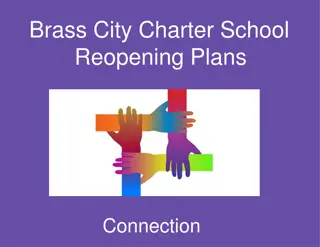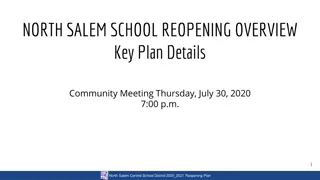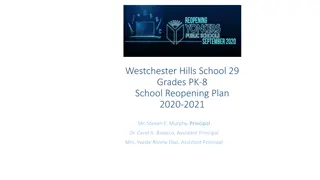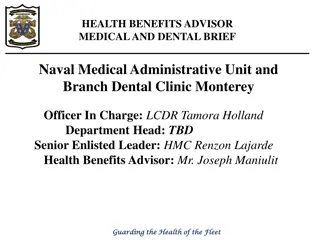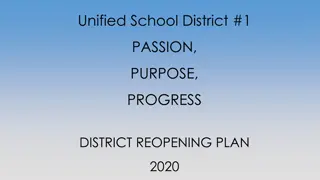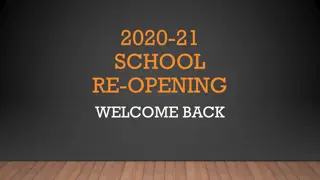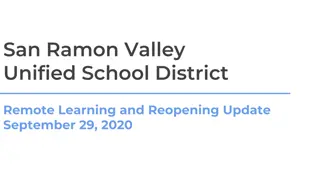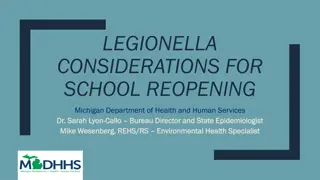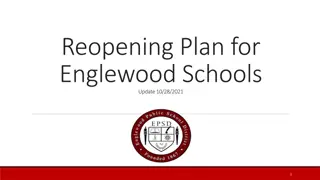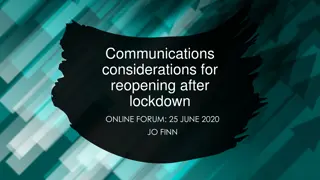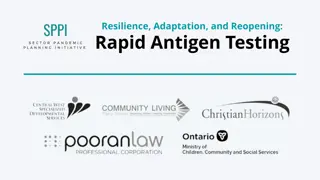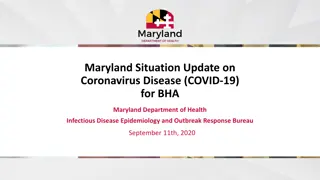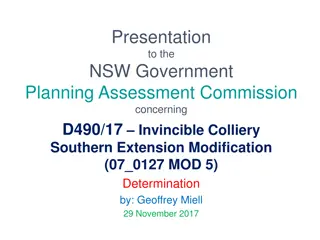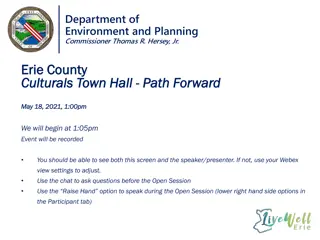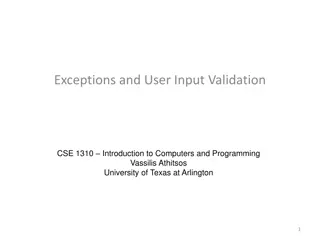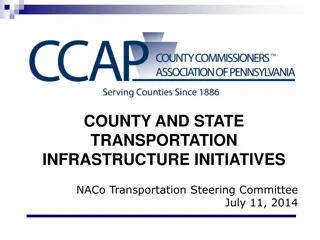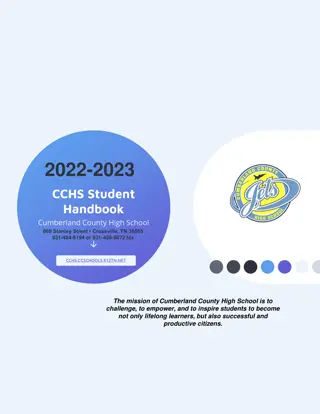Recommendations for School Reopening Input in Monterey County
The advisory body aims to gather input for planning the reopening of school sites in Monterey County. Participants are asked to provide suggestions on supporting families with daycare, technology, social-emotional issues, and more. Successes and concerns in distance learning, as well as ideas for improvement, are also sought. The guidance emphasizes contingency plans based on specific assumptions until a vaccine for COVID-19 is widely available.
Download Presentation

Please find below an Image/Link to download the presentation.
The content on the website is provided AS IS for your information and personal use only. It may not be sold, licensed, or shared on other websites without obtaining consent from the author. Download presentation by click this link. If you encounter any issues during the download, it is possible that the publisher has removed the file from their server.
E N D
Presentation Transcript
Welcome! I appreciate your participation in this advisory body. Our goal today is to inform you all the current recommendations of the Monterey County Office of Education.
Your charge today is to provide input today. This input will be used to inform our district management team and school site personnel in our planning for reopening school sites in the fall.
Please know that we are in the beginning phase of gathering input. We won t be making any decisions today, as we are lacking so much information and state/county guidance at this time.
Regarding the reopening of schools, what input might you provide regarding support for the family: such as daycare concerns, technology, social emotional issues, and any other considerations you would like to bring forward?
What are some successes you've had with supporting your child in Distance Learning? What are your concerns? What support do parents need with distance learning? What ideas do you have to make distance learning more effective?
COVID-19 Planning Guidance for Monterey County Schools and Districts May 2020
Planning Information and Assumptions Based on available information, it is reasonable and prudent for the PreK-12 schools in Monterey County to create contingency plans based on the following assumptions. 1. It will be safe for schools to return to normal operations when all the following have occurred: a. The California stay-at-home order has been lifted b. The directive to physically distance has been removed c. Limits on group gatherings have been lifted
Planning Information and Assumptions 2. The virus that causes COVID-19 will remain in circulation until a vaccine is developed and widely used. a. A vaccine is not likely to be in broad use during the next 18 months. b. During this time, improvements in understanding of the virus and in testing will allow public health officials to act with greater precision when taking steps to slow the rate of infection. Broad stay-at-home orders and long-term school closures are not likely to be needed in the future. c. A second wave of infections is expected, possibly coinciding with flu season in October or November. This resurgence will not be as significant as the first but could result in site, district, regional, or countywide school closures for possibly weeks at a time.
Planning Information and Assumptions 2. The virus that causes COVID-19 will remain in circulation until a vaccine is developed and widely used. d. Short-term closures of single or multiple schools must be considered until a vaccine is widely used. e. Children with significant health conditions will continue to be especially vulnerable during this time. f. Staff members with significant health conditions or are 65 or older will continue to be especially vulnerable at this time. g. Teaching and reinforcing prevention behaviors (handwashing and cough/sneeze etiquette) and promoting flu vaccinations will continue to be important strategies in slowing the spread of this and other infectious diseases.
Planning Information and Assumptions 2. The virus that causes COVID-19 will remain in circulation until a vaccine is developed and widely used. h. Frequent cleaning and disinfection of high-touch surfaces will also be needed throughout this period. i. School operations, including instruction, will not be the same as before the COVID-19 pandemic, and normalcy may not return for some time. Schools may need to consider how to maintain distance learning infrastructures and protocols for the next epidemic and pandemic.
Planning Information and Assumptions 3. Deaths from COVID-19 are possible while the virus is in circulation. a. Districts should determine appropriate supports for students, families, and staff members who may be in need of support with the grieving process. School counselors, grief busters and behavior health professionals all provide grief support as well as other partner agencies.
Planning Information and Assumptions 4. Student and employee attendance rates may decline in 2020-21. a. Students and staff with COVID-19, and those who are directly exposed, may miss two or more weeks of school. In larger households, children may be required to miss school for an extended period if the disease affects other members of their family. b. School staff are likely to become more concerned about COVID-19 symptoms and should encourage students and staff with symptoms to stay home.
Planning Information and Assumptions 5. Student learning outcomes going into the 2020-21 year will be uneven and vary broadly. a. Some students may begin the next year with additional learning needs. i. Consider the needs of Special Education Students ii. Consider the needs of Foster Youth iii. Consider the needs of Homeless Students iv. Consider the needs of English learners v. Consider the needs of Socioeconomically Disadvantaged Students
Planning Information and Assumptions 5. Student learning outcomes going into the 2020-21 year will be uneven and vary broadly. b. Districts should implement assessment and intervention procedures to address gaps in the learning process due to the loss or limitation of classroom instructional time.
Planning Information and Assumptions 6. Health and wellness resources, group counseling, therapeutic intervention will still be needed and required. a. How will schools continue to provide social-emotional services along with health and wellness resources? i. Create a plan to help equip staff to be responsive to students who have experienced trauma as a result of this crisis. ii. Create a plan to address the social-emotional needs of staff, students, and families to support the transition.
General Recommendations These general recommendations are provided to districts/schools to prepare and plan for the 2020-21 year in consideration of the rapidly changing and growing COVID-19 pandemic. Recommendations are provided by the Monterey County Office of Education in partnership with the Monterey County Health Officer. For questions about these recommendations, please contact MCOE Communications and Public Relations Officer, Jessica Hull at jhull@montereycoe.org.
General Recommendations 1. Carefully consider when to reopen schools within modified operations. The guidance by CDC for schools to prepare to readmit students will change over time. https://www.cdc.gov/coronavirus/2019-ncov/community/reopen- guidance.html. Cohorting will reduce the number of contacts when a student or teacher tests positive. Students who are cohorted in groups will likely be close contacts when a student or staff member tests positive. Screening for temperatures and symptoms for staff and students must occur at initial interaction with others.
General Recommendations 1. Carefully consider when to reopen schools within modified operations. Districts should consider the following questions while developing their modified operations reopening plans or when deciding if it is safe to do so: Are we prepared to open with coronavirus in circulation? What special accommodations do we need to protect vulnerable students and employees?
General Recommendations 1. Carefully consider when to reopen schools within modified operations. What supplies are needed to maintain heightened prevention measures (masks, face shields, hand sanitizer, cleaning, and disinfection products)? What are the new protocols for sanitizing and disinfecting? What signage will be required for enhanced safety measures and social distancing protocols?
General Recommendations 1. Carefully consider when to reopen schools within modified operations. How will meals be served? Students could also pick meals up and then return to class, which allows students to stretch their legs. If meals in classrooms cannot be achieved, then schools will be required to stagger meals more than currently in place to create social distancing and maintain cohorts. Tables would need to be labeled or wide open areas used. All food items should be boxed so students and staff are limited from touching individual pieces of food prior to eating. Package cutlery, napkins and sauces in single-serve packages. How will recess time and group play be managed? Monterey County Health Officer advises students to exercise as cohorts. There should be no use of shared equipment, even if sanitized after each cohort use.
General Recommendations 1. Carefully consider when to reopen schools within modified operations. Who will need to wear face coverings? The situation is going to change, and so will the shelter in place and face covering orders. Students may need to wear masks outside their classrooms, but not in the classroom since they are a cohort and considered a close contact if a classmate tests positive, even if they were wearing a mask. They can wear them voluntarily in class. Good chance this will become clearer as we get closer to opening, since it is the easiest thing to implement and change over the school year.
General Recommendations 1. Carefully consider when to reopen schools within modified operations. Evaluate our facilities to allow for proper social distancing. Verify a variety of entrances and exits for egress so as to allow for social distancing requirements, as provided. Will devices be allowed to be brought from home? What will be done to verify security while alternating internet access from home to school? How will devices be sanitized?
General Recommendations 1. Carefully consider when to reopen schools within modified operations. What items can be brought onto a school campus by students, staff and visitors and how are those items to be stored, sanitized, etc.? For schools whose students achieved virtual instruction during dismissal, schools could consider continuing this in the classroom and at home. Backpacks could be brought and placed on seat backs if desks are separated enough so that the student behind doesn t touch the other student s backpack (or jacket, etc).
General Recommendations 1. Carefully consider when to reopen schools within modified operations. What about shared items (classroom books, science lab equipment, etc.)? Monterey County Health Officer advises no books or equipment should be shared between cohorts. If students use lockers, this leads to mingling of cohorts. Schools would need to stagger, again, if possible to every fourth or fifth locker. This will lead to the need to allow students more time to access. Physical libraries should remain closed.
General Recommendations 1. Carefully consider when to reopen schools within modified operations. How will you allow for transportation to and from school (including busing, pick-up and drop-off lines, parking lots, etc.)? Even if all students arrive at the same time and are required to line up six feet apart and have their temperature taken, all students would not be in class at the same time. Therefore, staggered arrivals may be necessary.
General Recommendations 1. Carefully consider when to reopen schools within modified operations. How will you allow for transportation to and from school (including busing, pick-up and drop-off lines, parking lots, etc.)? Parents should remain in cars at all times.
General Recommendations 1. Carefully consider when to reopen schools within modified operations. How will school visitors be managed? Limit visiting hours for all visitors, including parents. Adjust protocols on receiving deliveries (postal service, UPS, etc.).
General Recommendations 2. Hold graduation and promotion ceremonies when it is safe to do so or in a virtual format. Develop plans to hold virtual graduation ceremonies if limits on group size prohibit larger gatherings. Consider all assemblies/large gatherings will not be allowed for many months.
General Recommendations 6. Consider the precautions necessary to protect students with special needs relative to the threat posed by COVID-19. What special procedures will be necessary to protect students in classrooms that serve severely handicapped students? For students who are not able to appropriately respond to health and safety directives, IEP teams may determine that individualized conditions for return may be necessary.
General Recommendations 7. Create plans to assess and respond to the uneven outcomes created by school closures. What formative assessment tools can we use to understand the individual and collective needs of our students? What is our plan to accelerate learning and close gaps?
General Recommendations 8. Develop a continuum of distance learning options. Consider developing robust independent study programs as an alternative for parents. Consider the use of learning centers to support student learning with weekly in- person and virtual appointments for support. Explore options for asynchronous learning for students who have health related concerns, or need schedule accommodations.
General Recommendations 9. Consider developing a continuum of strategies for implementation of social distancing. Identify all locations and times where students are in close contact with each other and create strategies to restructure those locations and activities. Teach/reinforce prevention behaviors (physical distancing, handwashing, and cough/sneeze etiquette, etc.) to minimize health concerns. Consider altering bell schedules, staggering start times, creating multiple recess and lunch periods, and creating multiple meal distribution points. In secondary schools, consider implementing a block schedule to reduce student movement during the day and cross contamination of classrooms.
General Recommendations 10. Consider these options when preparing a return to school plan. Option 1: Limit the number of students on campus to 50% of normal. Divide all classes into two equal groups: one would come to school on Monday and Wednesday, the other on Tuesday and Thursday. All teachers provide each group with two days of direct instruction and support, and three days of assignments to complete at home each week. Secondary schools could also implement a block schedule to reduce passing periods and lower the frequency of touches in each classroom.
General Recommendations 10. Consider these options when preparing a return to school plan. Option 2: Limit the number of students on campus to 20% of normal. All classes are divided into five equal groups: one for each day of the week. All teachers provide each group with one day of direct instruction and support, and four days of assignments to complete at home. Use Friday for teachers to provide individual or small-group support by appointment or to prepare packets for the next week.
General Recommendations 12. Develop and implement strategies to prevent the transmission of COVID-19 and other infectious diseases. Teach handwashing and cough and sneeze etiquette at all grade levels and reinforce on an ongoing basis. Schedule time and structure routines for handwashing at the start of each class period, and before and after meal times. Schedule frequent disinfection and sanitizing of high-touch surfaces. Open windows in classrooms, hallways, common spaces to increase ventilation. Consider holding instruction, activities and/or meals in outdoor settings.
General Recommendations 13. Remember that your education community is counting on your leadership and collaboration. Parents, students, teachers and staff: Take care of your health. Remember to give yourself downtime!


